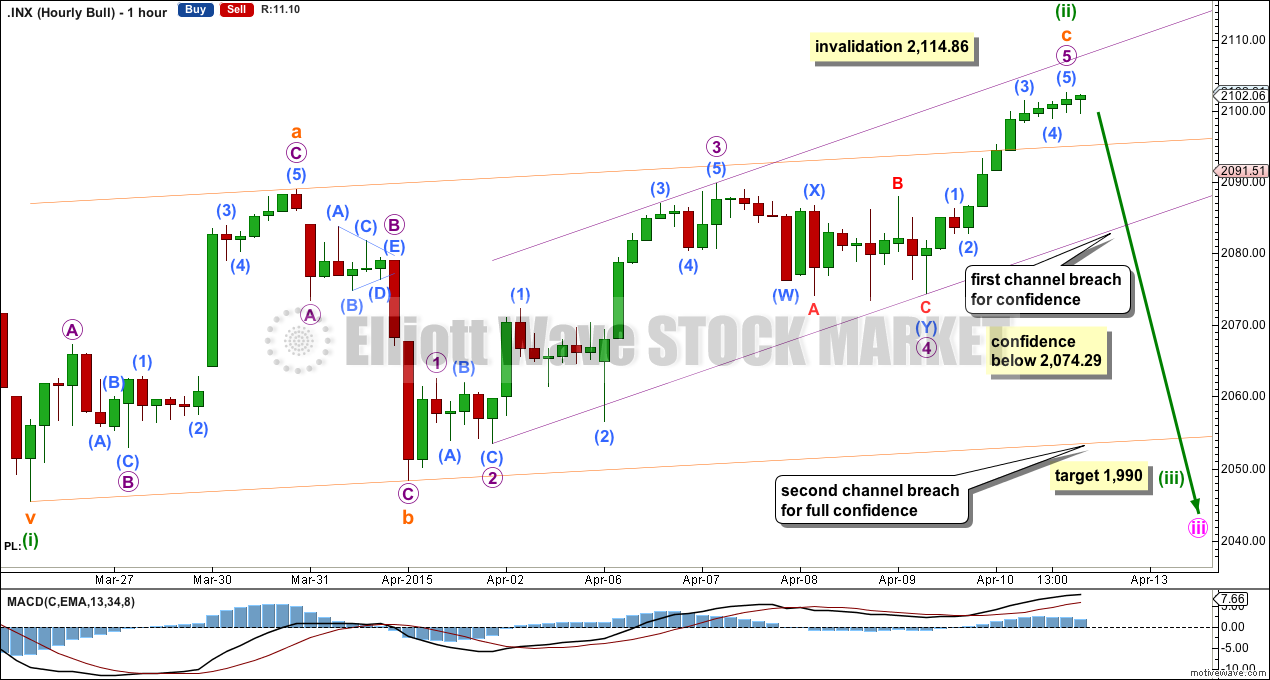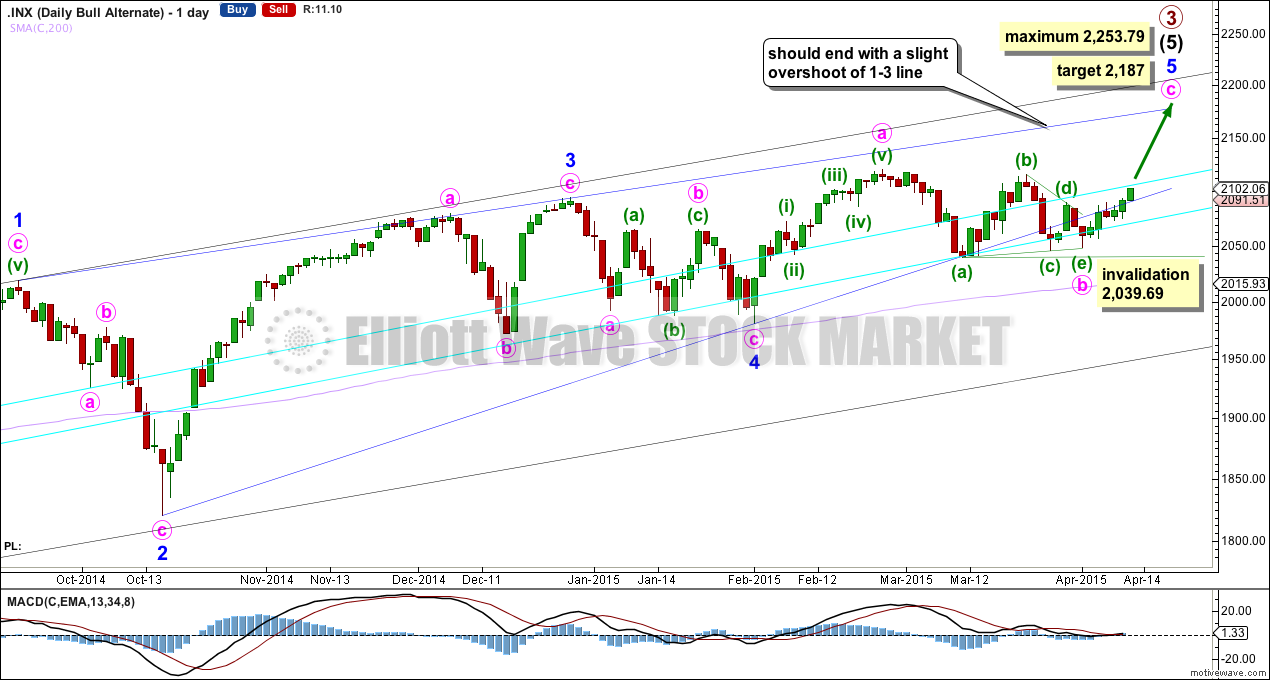Upwards movement continued, but remains below the invalidation point. Last Elliott wave analysis expected downwards movement to begin.
Summary: The S&P remains within a consolidation phase. I still expect the breakout, when it comes, should be downwards. I expect downwards movement to 1,990 to begin next week, but I will not have confidence that the trend has turned downwards until the upwards sloping violet channel on the hourly chart is breached. A new low below 2,074.29 would increase confidence that the trend has changed to down.
Click charts to enlarge.
Bullish Wave Count
If primary wave 3 is over then primary wave 4 should begin. Upwards movement from the low at 666.79 subdivides now as a complete 5-3-5. For the bull wave count this is seen as primary waves 1-2-3. The wave count sees intermediate wave (5) as an ending contracting diagonal. Ending diagonals require all sub waves to be zigzags.
Primary wave 2 was a relatively shallow 0.41 zigzag lasting 12 weeks. Primary wave 4 may be more shallow and is most likely to be a flat, combination or triangle. It may be longer lasting than primary wave 2 as these types of sideways corrective structures tend to be more time consuming than zigzags. Primary wave 4 is likely to end in the price territory of the fourth wave of one lesser degree between 1,730 – 1,647. It may last about 13 or maybe even 21 weeks, and has ended its sixth week.
To see a weekly chart and how to draw the aqua blue trend lines and the black channel, go here. Primary wave 4 should break below the black channel.
Primary wave 4 may not move into primary wave 1 price territory below 1,370.58. Invalidation of this bull wave count would provide full confidence in the bear wave count.
Because primary wave 4 may be an expanded flat, running triangle or double combination it may include a new high beyond its start at 2,119.59. If this happens the bear wave count would be invalidated.
There is triple (quadruple?) divergence with price and MACD at the weekly chart level supporting the idea of a trend change, either already or coming up soon.
A close 3% or more of market value below the double aqua blue trend line would provide trend line confirmation of a sizeable trend change. I will only have confidence in this wave count when there is confirmation of this trend change.
A new low below 1,980.90 would provide further confirmation of a trend change.
To have confidence in this big trend change the shorter 34 day SMA needs to cross below the longer 144 day SMA, and price needs to be below both.
So far within the sideways movement of minuette wave (ii) the strongest volume was on a down day. This indicates that when the breakout comes from this sideways consolidation phase it is more likely to be down than up.
Minuette wave (ii) can still be seen as a completed regular flat correction. There is no longer a Fibonacci ratio between subminuette waves a and c.
Ratios within subminuette wave c are: micro wave 3 is just 0.07 short of 2.618 the length of micro wave 1, and there is no Fiboancci ratio between micro wave 5 and either of 3 or 1.
In the first instance a breach of the Elliott channel about subminuette wave c would provide confidence that minuette wave (ii) is over and minuette wave (iii) is underway.
There is not enough downwards movement at the end of Friday’s session to conclude that micro wave 5 is over. A new low below its start at 2,074.29 is required to eliminate the possibility that it could continue higher.
Finally a clear breach of the wider orange channel about minuette wave (ii) would provide full confidence that it is over.
At 1,990 minuette wave (iii) would reach 1.618 the length of minuette wave (i).
While price remains above 2,074.29 and within the violet channel the risk that upwards movement will continue will remain. Minuette wave (ii) may not move above the start of minuette wave (i) above 2,114.86.
Alternate Bullish Wave Count
This alternate wave count is identical to the main wave count up to the low labelled minor wave 4. Thereafter, it sees minor wave 5 incomplete.
The lower 2-4 trend line of the contracting diagonal is now breached by three full daily candlesticks below it and not touching it. Diagonals normally adhere very well to their trend lines and this part of the wave count now looks wrong.
This wave count is still technically possible but it has a very low probability. The breach of the 2-4 trend line is the only reason why this wave count is an alternate.
Within the triangle of minute wave b, if minuette wave (c) continues further it may not move beyond the end of minuette wave (a) below 2,039.69. If we see a new low below this point this week I will discard this alternate wave count.
It is at this stage that this alternate wave count diverges from the main wave count. A new high above 2,114.86 would increase the probability of this alternate, and if it is correct we may see that this week.
Bear Wave Count
The subdivisions within primary waves A-B-C are seen in absolutely exactly the same way as primary waves 1-2-3 for the bull wave count. The alternate bull wave count idea also works perfectly for this bear wave count.
To see the difference at the monthly chart level between the bull and bear ideas look at the last historical analysis here.
At cycle degree wave b is over the maximum common length of 138% the length of cycle wave a, at 167% the length of cycle wave a. At 2,393 cycle wave b would be twice the length of cycle wave a and at that point this bear wave count should be discarded.
While we have no confirmation of this wave count we should assume the trend remains the same, upwards. This wave count requires confirmation before I have confidence in it. Full and final confirmation that the market is crashing would only come with a new low below 1,370.58. However, structure and momentum should tell us long before that point which wave count is correct, bull or bear.
This analysis is published about 01:00 a.m. EST.





I have a gut feeling both the main and alt wave counts are going to change entirely. This is starting to feel a little more bullish than it should if we are in a downtrend. The ED does not look right with the breach of lower trendline so that’s easy to discard. As far as the main wave count goes, I think the low at 2048 is going to represent a truncation. MACD is supporting a triangle with wave d almost complete. Wave e would end around 2080ish IMO and not breach 2074.29. The big problem is I have not looked into how this fits into the big picture wave count.
That idea has to fit into the larger picture. I’m still looking for an alternate at intermediate degree for primary wave 3. I’ll record this process today so you can see the issues as I see them.
If this sideways move is a B wave triangle as you suggest, then it could possibly be an early part of primary wave 4, but that would mean minor wave A within intermediate wave (A) would be a zigzag…. that’s possible I guess, but a primary degree correction should begin with a five down at the daily chart level. Not a three.